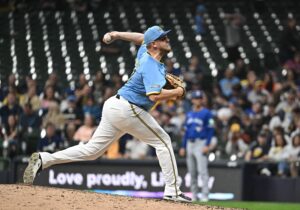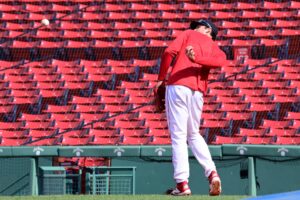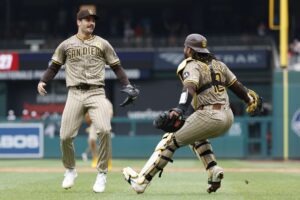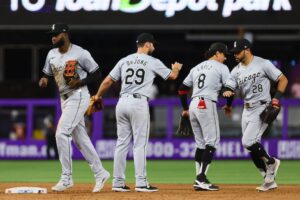Arizona Diamondbacks 2020 Season Review
It has been five weeks since the Arizona Diamondbacks 2020 season has ended. The dust has settled. Emotions have calmed. Heads are now clear. We’ve all had a chance to take a deep breath. Now that we’ve done so, let’s take a look at the shortened Diamondbacks 2020 campaign.
Going into the 2019 offseason, the biggest holes were in the starting rotation, middle relief, right field, and center field. They addressed the first one by signing veteran left-hander Madison Bumgarner to a five-year, $85 million contract in December. For the second, they signed Junior Guerra and Héctor Rondón. Guerra signed a one-year, $2.55 million contract with a $3.5 million team option in 2021. Rondón signed a one-year, $3 million contract with a club option for 2021. Kole Calhoun – a two-year, $14 million free agent acquisition – filled the third need. The last need was one that took the longest to address, but they did so via trade on January 27. On that date, they hauled in All-Star center fielder Starling Marte from the Pittsburgh Pirates in exchange for pitcher Brennan Malone and infielder Liover Peguero.
After an 85-77 record in 2019 where they outperformed expectations, these off-season moves put them in contention for at least a Wild Card spot in 2020. When the suddenly shortened season saw expanded playoffs put into place, that put the Diamondbacks in an even better position to play in October.
Then they started playing the games.
Diamondbacks 2020 Season Recap
A sluggish start out of the gate – dropping eight of their first eleven – saw them fall immediately to fifth place, 5 1/2 games behind the Colorado Rockies. They made up ground by winning 10 of their next 13. This put them in third place – 4 1/2 games behind the Los Angeles Dodgers – and in playoff position.
But after that, the wheels came off. Over the next three weeks, they lost 18 of 20, writing the epitaph for their playoff hopes. During that time, the trade deadline passed, putting Robbie Ray, Starling Marte, Andrew Chafin, and Archie Bradley in the uniforms of the Toronto Blue Jays, Miami Marlins, Chicago Cubs, and Cincinnati Reds, respectively. Madison Bumgarner – who had seemed off during the whole season – went on the injured list with a back injury. Ildemaro Vargas was designated for assignment and ended up having his contract sold to the Minnesota Twins. Embattled corner infielder Jake Lamb completed his fall from the 2017 All-Star season, getting DFAed after not being able to get anything going at the plate. He ended up turning it around for the Oakland Athletics, who have some former Diamondbacks coaches on their staff.
A 10-6 finish – one that saw the Diamondbacks win five of their last six – brought the final record to 25-35, fifth place in the National League West. They missed the playoffs by five games, just like 2019. The Diamondbacks also ended up with the second-worst record in the NL and sixth-worst in the majors. It was a season those in charge would like to forget while remembering whatever lessons need to be learned.
The Bad News
This was a season where it seemed like nothing went right. The starting pitching was 12th out of the 15 NL teams in ERA, with 5.04. They had the third-highest walks (119) and WHIP (1.404) and allowed the second-most home runs (59) while finishing with the sixth-highest opponent batting average (.255). Their relievers were ninth out of 15 in both ERA (4.60) and saves (13).
Bumgarner’s ERA (6.48) was the highest of his career by a large margin – almost two and a half runs – with the injury at least partly explaining it. Third baseman Eduardo Escobar posted a career-low batting average (.212), as did backup catcher Stephen Vogt (.167), whose average fell nearly 100 points below that of 2019 (.263). Catcher Carson Kelly also saw his batting average fall, although not nearly as far — .221 in 2020 from .245 in 2019.
Teams stole bases on the Diamondbacks at will. Most people superficially blame catchers for this, but those who saw the games know that this happened largely because the pitchers did not do a good job holding runners on. Opponents stole 40 bases against the Diamondbacks and were caught eight times – an 83% success rate in a year where the league average was 76%. Against Kelly, runners had 19 stolen bases and were caught three times (86% success). However, two of those were runners being caught attempting to steal home, meaning that Kelly only actually threw out one runner all season.
NL West Play
The team record against the San Francisco Giants was 1-2 at home and 1-6 on the road – 2-8 overall. This was a team they should not have had trouble with, a rebuilding franchise whose best players are either washed up or still developing. The Diamondbacks also had trouble with the Dodgers, going 2-8 against them as well. However, the Dodgers had the fifth-best winning percentage (.717) since 1901 and best since the 1954 Cleveland Indians (.721). On the other hand, the Giants had a much-lower .483 winning percentage.
This leads to another factor in the Diamondbacks 2020 struggles – play against their own division. The NL West had the two best teams (record-wise) in the league – the Dodgers and the 37-23 Padres. Against the NL West, the Diamondbacks 2020 record was 14-26. Their record outside the division – the 20 games against the AL West – was 11-9. They didn’t get the opportunity to prey on the weaker NL teams outside of their own division, so that certainly had an effect on the disappointing record.
The Good News
Despite the disappointing record and last-place finish, there were some bright spots. One was the breakout season from right-handed pitcher Zac Gallen. Ignore his win-loss record, as he suffered from a dearth of run support. His WHIP – 1.111 – was 10th in the NL. In walks, he was sixth-lowest in the NL. Strikeouts per nine – 10.250 – put him ninth. His 2.72 ERA was sixth in the NL, and his ERA-minus of 61 was fifth. If not for two bad innings – a four-run sixth inning against the Giants on September 7 with no outs recorded and a four-run first inning against the Seattle Mariners on September 12 – his ERA would have been 1.77. That would have been an ERA-minus of 36 – one lower than the NL-record 37 from Greg Maddux in 1994. (Yes, it’s a short season, so it would have been its own category, but it is still worth mentioning.)
Batting Highlights
Kole Calhoun also had a good season. He was a Gold Glove finalist in right field while leading the team in home runs (16), RBI (40), slugging percentage (.526), wOBA (.362), and wRAA (8.2). In home runs, he was tied for third in the NL, while his RBI were tied for ninth. He had a low batting average (.226), yet his strikeout percentage (21.9%) was lower than the NL average (23.1%). That, coupled with a high barrel percentage of 11.8%, indicates that his lower-than-expected batting average was due to a high amount of “atom balls.” (Read it out loud. He hit it hard, but right “at him,” as in the defender.)
Christian Walker had the best batting average of his career in 2020, hitting .271 with a .339 wOBA. He also posted career highs in extra-base hit percentage (10.7%), extra-base hits per hit (44%), and line drive percentage (29%). His strikeout rate dropped to a career-best 20.6%. David Peralta had his best batting average (.300) since 2015 (.312) while also being a finalist for the Gold Glove. Starling Marte played well before getting traded, leading the team in hitting with a .311 average.
Other Good News
Another piece of good news is that the Diamondbacks had a winning record at home (16-14), although that might be small solace in a last-place season. However, one piece of encouraging news is their play over the final two weeks, when they went 8-4 and won five of their last six. Manager Torey Lovullo said in the end-of-season press conference that a longer season would have seen them “chase some teams down,” and their play on the field backed up his claim. One individual who played exceptionally well over that stretch was Kelly, who batted .345 (10-for-29) over the final two weeks to raise his average from a dismal .183 to .221, which is also his career batting average.
Outlook
It is hard to imagine 2021 going worse than 2020 did for the Diamondbacks. As mentioned before, little seemed to go right. For example, as mentioned before, they went 2-18 from mid-August to mid-September. This was their worst skid since a 3-22 stretch in their 111-loss 2004 season, which was the most losses in team history. What made the 2020 losing streak so frustrating was the fact that they were in most of the games, as 13 of the 18 losses were by three runs or fewer. Furthermore, the five losses that were by four runs or more were all games where they kept it close for most of the game only to have it get away from them late.
It would be both dishonest and intellectually lazy to blow the season off as being “bad luck,” but it would be irresponsible to ignore bad luck as a factor. In a full 162-game season, luck tends to even out due to the law of averages, but in a two-month, 60-game season, that may not happen. We don’t know for sure.
We do know one thing, though. These players are not happy with the results, and they will bust their tails to improve. The team has already declined options on Mike Leake, Junior Guerra, and the completely ineffective Héctor Rondón. General manager Mike Hazen will be working round the clock in the offseason to use his limited budget to address the team needs, mainly in the area of relief pitching. Look to see an improved product in 2021.
Main Photo
Embed from Getty Images






